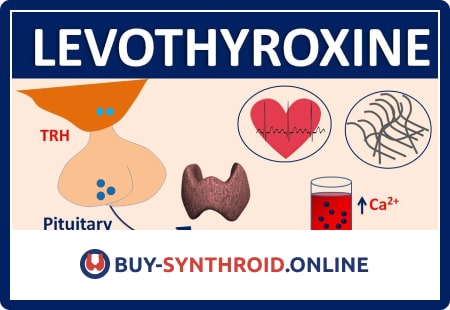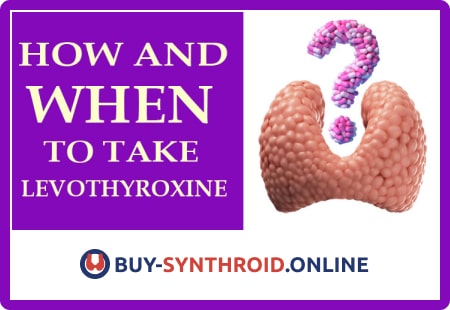
Levothyroxine
Pharmacotherapeutic group: Thyroid medication
Pharmacological action
Preparation of thyroid hormones. A synthetic left-handed isomer of thyroxine. In small doses it has an anabolic effect. In medium doses it stimulates growth and development, increases tissue oxygen demand, stimulates metabolism of proteins, fats and carbohydrates, stimulates cardiovascular system and CNS. In high doses it inhibits hypothalamic TTH and pituitary TTH production.
Pharmacokinetics
After oral administration is absorbed from the gastrointestinal tract, absorption is 48-79%. Fasting food increases absorption of the active substance. Cmax in plasma is reached after about 6 hours. Binding with plasma proteins (thyroxine-binding globulin, thyroxine-binding prealbumin and albumin) is more than 99%. Vd is 0.5 l/kg. Distribution occurs mainly in the liver, brain and muscles.
In various tissues approximately 80% of levothyroxine sodium is monodeoxidized to form triiodothyronine (T3) and inactive products. A small amount of the active substance undergoes deamination and decarboxylation to form tetraiodothyroacetic acid, as well as conjugation with sulfuric and glucuronic acids (in the liver).
T1/2 is 6-7 days. About 15% is excreted by the kidneys and with bile unchanged and as conjugates.

Indications of active substances of Levothyroxine
Hypothyroidism; euthyroid goiter; as replacement therapy and for prevention of goiter recurrence after thyroid resection; thyroid cancer (after surgical treatment); diffuse toxic goiter: after achieving euthyroid state with antithyroid drugs (as combined or monotherapy); as a diagnostic agent for thyroid suppression test.
Dosing regimen
 The method of administration and dosing regimen of a particular drug depend on its form of release and other factors. The optimal dosing regimen is determined by the doctor. It is necessary to strictly follow the compliance of the used dosage form of a particular drug with the indications for use and the dosing regimen.
The method of administration and dosing regimen of a particular drug depend on its form of release and other factors. The optimal dosing regimen is determined by the doctor. It is necessary to strictly follow the compliance of the used dosage form of a particular drug with the indications for use and the dosing regimen.
It is established individually depending on indications.
Administered in a dose of 12.5-200 mcg once daily 20-30 min before meals.
When conducting differential diagnostic test of thyroid suppression - once in a dose of 3 mg or for 2 weeks in a dose of 200 mcg once a day.
Side effect
Symptoms of hyperthyroidism: tachycardia, palpitation, arrhythmias, angina pectoris, headache, nervousness, tremor, sleep disturbances, insomnia, muscle weakness and seizures, weight loss, diarrhea, menstrual irregularities, vomiting are possible (if used in high doses, including too rapid dose increase at the beginning of treatment).
Contraindications to use
Hypersensitivity to sodium levothyroxine, untreated thyrotoxicosis, acute myocardial infarction, acute myocarditis, untreated insufficiency of the adrenal cortex.
 Caution: in diseases of the cardiovascular system - CHD (atherosclerosis, angina pectoris, myocardial infarction in anamnesis), arterial hypertension, arrhythmia; in diabetes, severe long-term hypothyroidism, malabsorption syndrome (dose adjustment may be required).
Caution: in diseases of the cardiovascular system - CHD (atherosclerosis, angina pectoris, myocardial infarction in anamnesis), arterial hypertension, arrhythmia; in diabetes, severe long-term hypothyroidism, malabsorption syndrome (dose adjustment may be required).
Administration during pregnancy and lactation
During pregnancy and lactation (breast-feeding) levothyroxine sodium should be used with caution, strictly in the recommended doses, under medical supervision.
Using in combination with thyreostatic agents during pregnancy is contraindicated due to increased risk of fetal hypothyroidism.
Administration in children
It is possible to use in children under indications in dosages and dosage forms recommended according to their age.
Use in elderly patients
In elderly patients and in long-term hypothyroidism, treatment should be started gradually.
Special directions.
- With particular caution, use in patients with cardiovascular disease (including CHD, heart failure, arterial hypertension). In such cases, levothyroxine sodium should be used in a low initial dose, increasing it slowly and at long intervals.
- If hypothyroidism is caused by a pituitary gland lesion, it is necessary to find out whether there is simultaneously an insufficiency of the adrenal cortex. In this case, GCS replacement therapy should be started before treatment of hypothyroidism with thyroid hormones to avoid development of acute adrenal insufficiency.
- In elderly patients and in long-term hypothyroidism treatment should be started gradually.
- Use with caution in diabetes mellitus and non-sugar diabetes.
- In differential diagnostic test of thyroid suppression in patients with diabetes mellitus it is recommended to increase the dose of antidiabetic agents.
- In some cases, thyroid hormones may cause or aggravate a previous myasthenic syndrome.

Drug interaction
Sodium levothyroxine potentiates the effect of indirect anticoagulants (coumarin derivatives), reduces the effectiveness of oral hypoglycemic agents.
In patients with hypothyroidism and concomitant diabetes mellitus at the beginning of replacement therapy with thyroid hormone preparations may increase the need for insulin or oral hypoglycemic agents.
Salicylates, dicoumarin, furosemide (250 mg), clofibrate may displace levothyroxine from plasma protein binding.
Sucralfate, aluminum hydroxide, calcium carbonate reduce absorption of levothyroxine from the GI tract.
Colestiramine reduces absorption of levothyroxine sodium from the gastrointestinal tract.
When using ritonavir, there may be an increased requirement for levothyroxine.
When using sertraline in patients with hypothyroidism, the effects of levothyroxine sodium may be reduced.
During rapid IV administration of phenytoin against the background of levothyroxine sodium administration, plasma levels of free levothyroxine may increase, and arrhythmias may be observed.
Concomitant use of chloroquine may increase levothyroxine metabolism, apparently due to induction of liver microsomal enzymes by chloroquine. In patients receiving levothyroxine sodium, proguanil or chloroquine may increase TTH concentrations.
The use of tricyclic antidepressants with levothyroxine sodium may lead to increased effect of antidepressants.
Levothyroxine sodium reduces the effect of cardiac glycosides. When concomitant use colestyramine, colestipol and aluminum hydroxide reduce plasma concentration of sodium levothyroxine due to inhibition of its absorption in the intestine.
When concomitant use with anabolic steroids, asparaginase, tamoxifen possible pharmacokinetic interaction at the level of protein binding.
Somatotropin concomitant use with sodium levothyroxine may accelerate closure of epiphyseal growth zones.
Administration of phenobarbital, carbamazepine and rifampicin may increase the clearance of sodium levothyroxine and require increasing the dose.
Estrogens increase the concentration of the thyroglobulin-bound fraction, which may reduce the effectiveness of the drug.
Amiodarone, aminoglutethimide, para-aminosalicylic acid (PASC), ethionamide, antithyroid drugs, beta-adrenoblockers, chloral hydrate, diazepam, levodopa, dopamine, metoclopramide, lovastatin, somatostatin affect the synthesis, secretion, distribution and metabolism of levothyroxine sodium. Products containing soybeans may decrease the absorption of levothyroxine sodium (dose adjustment may be required).
 DE
DE FR
FR IT
IT ES
ES



